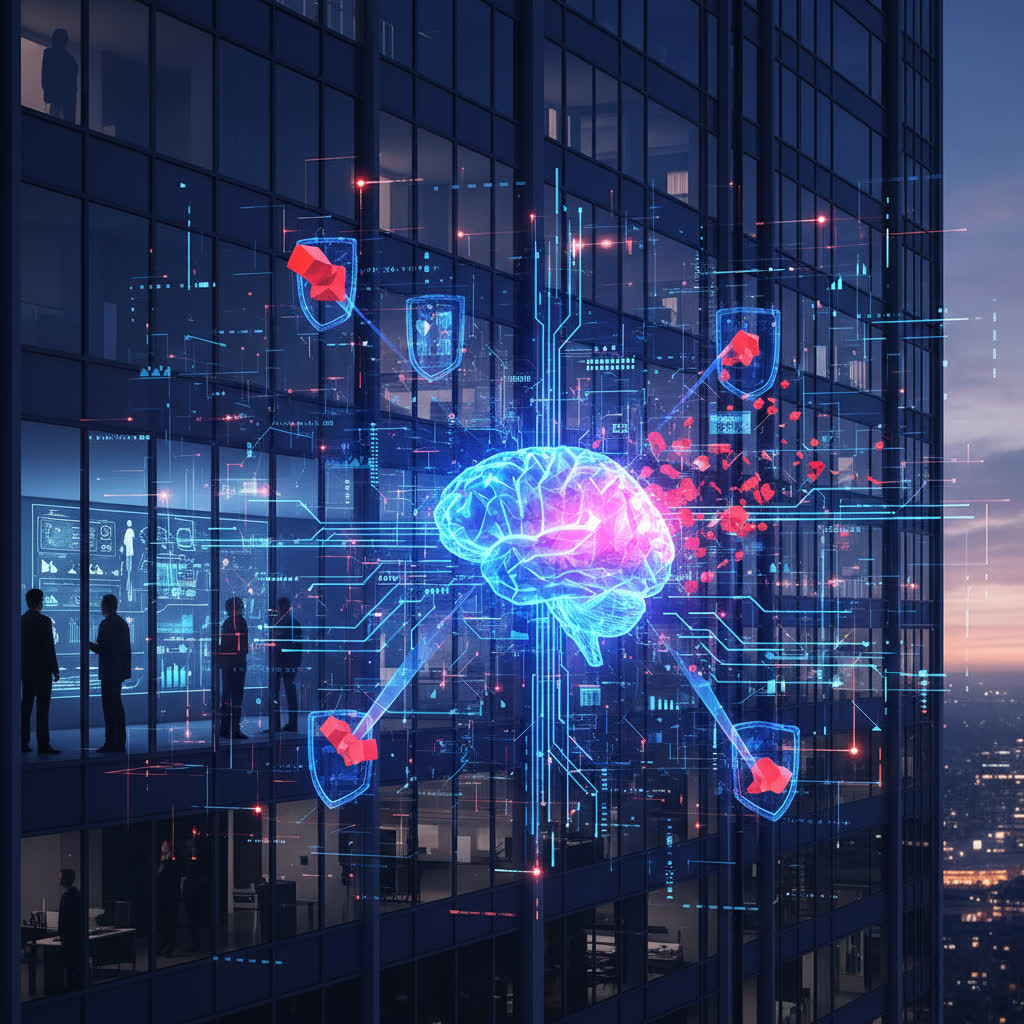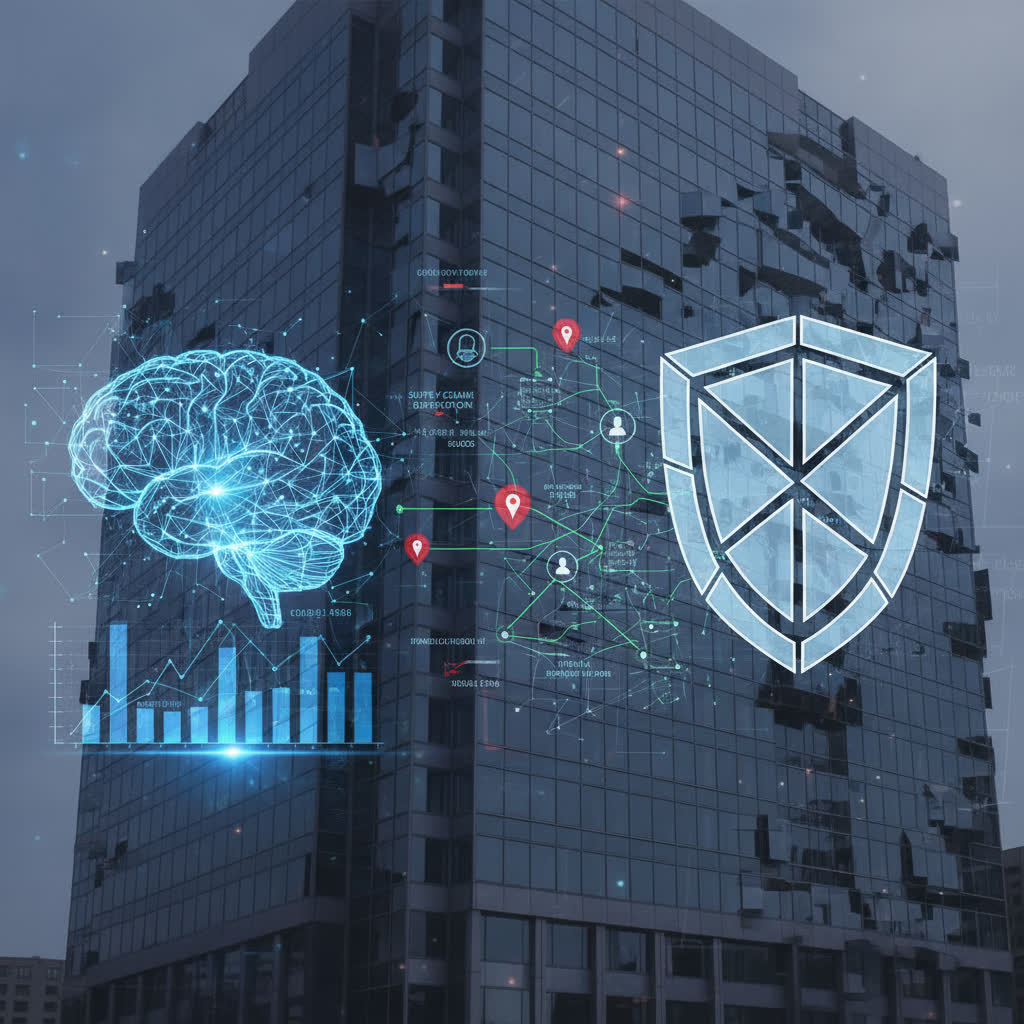Artificial intelligence is transforming the way organizations protect their digital environments from threats. As cybercrime becomes ever more sophisticated and attackers develop new techniques, businesses must look beyond traditional tools. Artificial intelligence offers new solutions, enabling organizations to anticipate and counteract threats in real time. By integrating intelligent algorithms, companies can identify vulnerabilities, detect anomalies and respond more effectively to security incidents, reducing the impact of potential breaches on their operations.
The Shifting Enterprise Security Landscape
With digital transformation permeating all sectors, enterprises are expanding their digital footprints. Cloud adoption, remote work and connected devices have introduced novel risks. Attack surfaces have grown, stretching defenders thin. Cyber attackers now leverage automation, malware and phishing campaigns that adapt rapidly. Security teams deal with thousands of alerts daily, making it hard to identify genuine threats amid routine noise. Human-led detection and response are struggling to keep up, and organizations can no longer rely only on static rules or manual processes for protection.
The Need for Adaptive Security Frameworks
As security strategies mature, businesses are shifting toward proactive and adaptive defense models. Automation and continuous monitoring have proven essential. Static perimeters give way to a focus on identity-based security, continuous authentication and context-aware controls. Artificial intelligence adds another layer, granting systems the ability to learn over time and recognize unusual activities even as attack patterns shift. This adaptability positions artificial intelligence as an essential ally for modern enterprise defenses.
Artificial Intelligence: Defining its Role
Artificial intelligence draws from fields like machine learning, neural networks and data analytics. In threat detection, it processes vast sets of data far faster than any human could. It ‘learns’ to recognize expected and unexpected activities, building models that anticipate known as well as unknown threats. Unlike traditional signature-based systems, artificial intelligence systems analyze real-time network data, user behavior and application performance to judge whether a security event warrants attention.
Types of Artificial Intelligence Used in Threat Detection
There are several forms of artificial intelligence at work in threat detection. Machine learning algorithms are common, ingesting historical data to build predictive models. Deep learning techniques allow systems to analyze data with greater nuance, often uncovering hidden patterns. Natural language processing techniques help analyze logs, emails or chat communications for social engineering attacks. The integration of multiple approaches enhances detection accuracy across diverse threat landscapes.
Continuous Learning for Evolving Threats
The strength of artificial intelligence lies in its capacity to evolve. As it analyzes new data, artificial intelligence continuously updates its understanding of normal behavior and attack signatures. This learning curve enables faster recognition of zero-day attacks, novel malware, or insider threats that evade traditional controls. Over time, the models become more effective, flagging subtle anomalies that might otherwise go undetected.
Core Capabilities of Artificial Intelligence in Threat Detection
Artificial intelligence brings several capabilities to enterprise threat detection. Anomaly detection stands out, as artificial intelligence models quickly recognize deviations from established norms. For example, if an employee accesses a sensitive database outside of regular hours, artificial intelligence systems can alert analysts instantly. These models also distinguish between benign policy violations and genuine threats, reducing false positives and improving efficiency throughout the incident response chain.
Automated Incident Investigation
Artificial intelligence automates the investigation process by gathering event data and correlating it across sources, presenting analysts with actionable insights. This dramatically reduces the time needed to triage alerts. Artificial intelligence-driven platforms use correlation rules, probability scoring and association mapping to determine whether certain patterns merit deeper investigation. They can also recommend remediation actions, guided by previous successful responses or updated policy standards.
Predictive Analytics and Threat Intelligence
Threat intelligence platforms that leverage artificial intelligence ingest data from global sources, analyzing indicators of compromise in real time. Predictive analytics uncover trends that help anticipate future campaigns or pinpoint sensitive assets at higher risk. With automation, security teams receive context-rich information, allowing for more strategic decision-making and resource allocation. These models support threat hunting initiatives by surfacing emerging risks before they escalate into major incidents.
Security Operations Centers: Artificial Intelligence in Practice
In Security Operations Centers, professionals face a daily influx of security alerts, some actionable and some benign. Artificial intelligence platforms support analysts by prioritizing threats based on severity, context and potential business impact. By filtering noise, artificial intelligence improves the focus of human operators, ensuring high-risk incidents receive immediate attention. Real-time capabilities help reduce ‘alert fatigue’ and improve incident response times.
Empowering Human Analysts
While artificial intelligence enhances efficiency, human expertise remains vital. Artificial intelligence handles data at scale, but analysts still provide context, interpret nuanced situations and manage complex investigations. Artificial intelligence becomes a ‘force multiplier’ rather than a replacement. The partnership yields stronger outcomes, pairing computational power with human judgment and experience. Through ongoing feedback, artificial intelligence models improve, creating a virtuous cycle of learning and defense refinement.
Streamlining Workflow and Collaboration
Effective threat response depends on coordinated workflows. Artificial intelligence integrates with ticketing systems, orchestrates playbooks and automates repetitive tasks. This eliminates manual bottlenecks and allows security teams to focus on critical analysis and response efforts. Automated reporting and case management make it easier to track incidents, share intelligence and document lessons learned. Cross-functional teams, including IT, compliance and legal departments, benefit from unified data streams and synthetic insights produced by artificial intelligence.
Machine Learning and Deep Learning in Security
Different artificial intelligence techniques suit different aspects of enterprise threat detection. Machine learning models excel at classifying normal and abnormal events, based on an organization’s unique patterns. These can range from unusual login times to data exfiltration attempts. Deep learning models, inspired by the human brain, process complex data sets such as network flows, user activity sequences or even audio-visual signals to detect sophisticated threats that escape simpler techniques.
Supervised and Unsupervised Learning Approaches
Supervised learning methods require labeled data, such as known malware samples or previously detected intrusions. The model learns to identify these threats with high precision. Unsupervised learning analyzes unstructured data, spotting hidden relationships without prior labeling, making it ideal for discovering unknown or emerging attack techniques. Semi-supervised approaches blend both, offering a pragmatic path for organizations without extensive labeled data sets.
Feature Engineering for Security Applications
Feature engineering determines which aspects of the data artificial intelligence models will analyze. In security, features might include login frequency, network traffic volumes, email sender domains or access request patterns. Selecting the right features enhances detection rates and minimizes false positives. Security teams collaborate with data scientists to refine feature sets, ensuring artificial intelligence aligns with actual risk scenarios facing the business. This collaboration strengthens risk profiling, outlier recognition and rapid intervention.
Artificial Intelligence and Behavioral Analytics
Behavioral analytics involves tracking user actions and system interactions to identify deviations indicative of attacks. Artificial intelligence models mine historical data, establishing logical baselines for behaviors such as software usage, file changes or workspace access patterns. When a user suddenly downloads large volumes of sensitive data or accesses resources seldom used, artificial intelligence raises alerts for further investigation.
User and Entity Behavior Analytics (UEBA)
User and entity behavior analytics platforms build comprehensive profiles for every user and device on a network. Artificial intelligence analyzes these profiles to identify changes, whether they are subtle or significant. Anomalies may reflect insider threats, credential abuse or account compromise. Artificial intelligence-based UEBA systems help mitigate risks by flagging suspicious activities early, giving organizations more time to respond and prevent data breaches.
Addressing Threat Types with Artificial Intelligence
Artificial intelligence assists in countering a wide variety of enterprise threats. Traditional defense mechanisms often fail to catch polymorphic malware, which mutates frequently to evade detection. Artificial intelligence models recognize behavioral signatures rather than static patterns, improving the odds of catching such elusive threats. Likewise, artificial intelligence excels in detecting phishing attempts, advanced persistent threats and ransomware campaigns by evaluating not just payloads but also delivery methods and underlying intentions.
Mitigating Insider Threats and Account Compromise
Insider threats, whether malicious or accidental, remain a significant challenge. Artificial intelligence platforms examine diverse factors, including privilege escalation attempts, anomalous data transfers or abrupt changes in user routines. By correlating signals across endpoints, networks and cloud environments, artificial intelligence exposes subtle indicators of compromise. Early detection empowers security teams to remediate issues before they escalate into severe breaches or regulatory violations.
Combating Social Engineering and Email Attacks
Social engineering leverages deception rather than technical exploits. Phishing emails and spoofed messages continue to bypass many basic filters. Artificial intelligence reviews message metadata, content and sender behavior to spot fake communications with high accuracy. Natural language processing models assess linguistic nuances, flagging attempts that mirror past attack patterns or contain suspect attachments. Automated response mechanisms help neutralize threats before users engage with them.
Compliance, Governance and Risk Management Applications
Staying ahead of regulatory mandates, such as GDPR, SOX and ISO 27001 requirements, puts additional pressure on enterprise security teams. Artificial intelligence-powered systems streamline compliance by automating controls, monitoring for policy deviations and generating audit-ready reports at scale. By tracking sensitive data flows and system configurations, artificial intelligence reduces compliance gaps and expedites risk assessments. Its ability to correlate disparate data points is a valuable asset for governance, risk and compliance functions.
Managing Audit Readiness and Reporting
Audit cycles require transparency, accuracy and timeliness. Artificial intelligence expedites this process, automating evidence collection, flagging control weaknesses and identifying process deviations. Teams can visualize compliance trends, remediate deficiencies and maintain a strong ‘audit posture’ year-round. Artificial intelligence-driven analytics help prioritize corrective measures for issues with the greatest regulatory or operational impact, ensuring controls remain effective as standards evolve.
Enabling Proactive Risk Management
Beyond compliance, artificial intelligence informs broader risk management initiatives. It identifies emerging risks, quantifies potential impacts and simulates ‘what if’ threat scenarios. Continuous monitoring equips organizations to enact preventive strategies. Automatic adjustment of controls becomes possible based on live threat intelligence, refining security postures and reducing overall risk exposure. This data-driven approach strengthens both immediate defenses and long-term risk governance frameworks.
Challenges and Limitations of Artificial Intelligence in Security
While artificial intelligence brings transformative benefits, deploying it is not without obstacles. High-quality input data is essential for model accuracy. Adversaries may seek to poison training sets or trigger artificial intelligence ‘blind spots,’ undermining detection. Over-reliance on algorithms can cause teams to miss context or fall behind on adapting to new threat tactics. Resource requirements for model training and maintenance can also be significant, especially for organizations with limited budgets or specialized talent pools.
Addressing Data Privacy and Bias Concerns
Artificial intelligence systems often handle sensitive information. Ensuring privacy throughout data collection, processing and storage remains a top challenge. Governance frameworks and transparency standards are crucial in building trust. Bias in artificial intelligence models can lead to unfair outcomes or missed threats if not addressed. Regular audits of artificial intelligence algorithms and measures to reduce bias help maintain accuracy and fairness in threat detection systems.
Ensuring Human Oversight and Accountability
No artificial intelligence system should operate fully autonomously in high-stakes environments. Human analysts must guide artificial intelligence deployments, assess flagged incidents and oversee remediation. Combining technology with expert oversight provides the balanced approach necessary for effective enterprise security. Regular training and updates ensure artificial intelligence models remain aligned with both business needs and shifting threat landscapes.
The Future of Artificial Intelligence in Enterprise Security
Artificial intelligence’s role in enterprise security will continue to expand throughout 2025 and beyond. Advances in quantum computing, graph analytics and federated learning promise to drive even greater capabilities. Digital ecosystems will grow more interconnected, with artificial intelligence-powered defenses forming the fabric of secure business operations. New applications will emerge, including automated deception, crowd-sourced threat sharing and real-time risk scoring to support business decisions. As artificial intelligence continues to mature, organizations will benefit from greater adaptability, resilience and collaboration in their ongoing fight against cyber threats.
Industry Best Practices for Adopting Artificial Intelligence
Enterprises looking to adopt artificial intelligence for threat detection should start with a clear understanding of their risk profile and priority assets. Data quality and diversity underpin effective machine learning. Collaborating across security, IT and business units promotes holistic protection. Starting with pilot projects, refining models through feedback and reviewing performance metrics helps drive continuous improvement. Training teams on both the benefits and constraints of artificial intelligence ensures realistic expectations and sustainable progress.
Building a Culture of Security Innovation
Sustained success with artificial intelligence requires a culture of innovation. Encouraging experimentation, learning from incidents and sharing insights build collective expertise. Cross-disciplinary collaboration accelerates both detection capabilities and defensive agility. Prioritizing ethical artificial intelligence use, privacy and transparency builds trust with stakeholders and aligns technology initiatives with organizational values. As artificial intelligence technologies mature, those who integrate them responsibly will best position themselves to respond effectively to emerging threats.
Case Studies: Artificial Intelligence-Driven Threat Detection
Across industries, real-world deployments illustrate the promise and challenges of artificial intelligence in threat detection. In financial services, artificial intelligence identifies fraudulent transactions in milliseconds, protecting both institutions and customers. Healthcare organizations leverage behavioral analytics to secure patient records and safeguard against ransomware. Retailers use artificial intelligence-driven models to identify compromised accounts and prevent fraud while ensuring seamless customer experiences. These examples underscore the importance of contextual data, continuous learning and integrated human oversight in building robust artificial intelligence-driven defenses.
The Human Element: Empowering Security Teams
Artificial intelligence takes on the heavy lifting in data analysis, but human intuition and expertise drive holistic protection. Security teams must stay current with emerging tactics, updating artificial intelligence parameters as necessary. Ongoing training ensures analysts can interpret artificial intelligence-generated alerts, investigate incidents accurately and manage remediation. By blending advanced technology with human judgment, organizations create agile and responsive defense strategies to meet the demands of a rapidly shifting threat environment.





